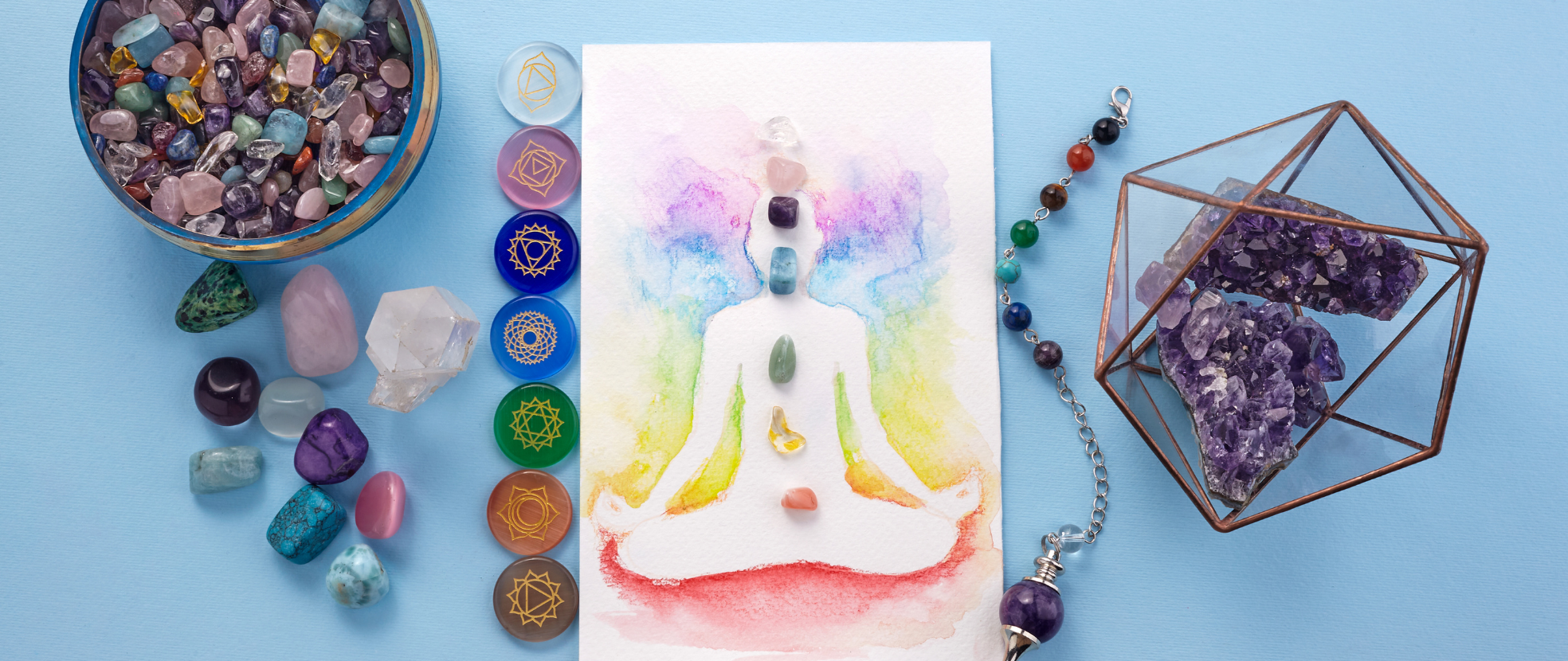A pendulum is a crystal, glass, wood, or metal that hangs from a cord or string. When you were younger, you probably sought the help of a magic eight ball to get a yes/no answer or played eenie meenie miney moe when you couldn't decide which dress to wear to an occasion.
A pendulum serves a similar purpose; it's a divination tool for answering questions, making decisions, and receiving spiritual guidance. It also comes in handy when clearing negative energies.
Where did pendulums originate? And how do they work? Let's dig deeper.
A Brief History of Pendulums
A pendulum swings from side to side. It moves in a constant period as long as its angle isn't more than 20 degrees. The use of a pendulum traces back to ancient Egypt and Rome.
Evidence suggests it was used for dowsing or the method of locating ground water, gemstones, oil, gravesites, and buried metals or ores in the earth. The pendulum is held over and moved motionless across a map. Once it begins to swing or drop, the location is recorded.
It is also said that Galileo Galilei began the innovation of using pendulums for timekeeping in the 1600s. And in 1657, physicist and mathematician Christian Huygen built on Galileo's findings to produce the standard timekeeping instrument.
In healthcare, holistic medical practitioners would use a pendulum to diagnose a patient's medical condition, locate infections, and identify the appropriate course of treatment. This is done by holding the device over various parts of the patient's body.
Healers and psychics have been using pendulums for dowsing since time immemorial. They use pendulums made of a crystal or a gold ring hanging from a gold chain or silk cord to seek out the unknown.
In this method of inquiry, the pendulum works as a transmitter from divine forces and a receiver of wisdom. The user then asks yes and no questions, which is the most direct way to inquire through this tool.

How Do Pendulums Work, Really?
Okay. So we've unpacked how pendulums have been used over the years for various purposes. But how does it actually work in dowsing and divination work?
Psychics and healers believe the tool works by opening up your intuition. In many cases, the answers you need to make certain decisions are already inside of you.
However, distractions in the form of fear, worry, anxiety, or limiting beliefs might be difficult for you to retrieve these truths the instant you need them.
So in come pendulums. They unite the left and right hemispheres of your brain. When both sides are in harmony, you can work up a viable solution based on knowledge from your intuitive and rational mind.
Pendulums help you cut through the noise; it clarifies your thought process so you can think clearly.
Spiritually, these tools increase your awareness and focus so you can connect effectively with your spirit guides and guardian angels.
Many people doubt the accuracy and truthfulness of the answers that pendulums give, thinking the pendulum is merely responding to the movement of the user's hand.
Of course, regardless of the query being made, the pendulum can always be made to follow the direction of your hand.
But like other divination practices, using a pendulum requires faith and an open mind. It involves letting go of those what ifs and fully trusting that any answers you'll get come from your intuition and spirit guides.
When Should I Use a Pendulum?
Pendulums guide, raise your awareness, and help you gain clarity.
While it could give you direct answers, it's not a tool you should use to make ALL your decisions for yourself. It can only be useful in specific scenarios.
For example: you can ask a pendulum some questions to have a clear understanding of anything related to life, love, career, finances, or health. You can consult your pendulum anytime you need to, given that you approach it as a spiritual practice. Use it to have some guidance on a problem or to obtain clarity over a difficult situation.
You can also use a pendulum to:
- Cleanse and drive out negative energies from your space
- Identify allergies
- Find lost objects
- Find water lines
Whatever that query may be, remember the pendulum can only answer yes or no questions and not open-ended ones. You can always phrase an issue, question, or decision into a yes or no format to get a clear answer.
Note that the pendulum connects with your own energy, which is constantly shifting during the day. So it's normal to get varying answers from time to time.
It's not to say though that the pendulum is fickle. It's an invitation to be bold with your intentions, be clear with the answers you want to get, and to hone your energy and attention better to connect with the pendulum effectively.
The following factors could also prevent your pendulum from working (not swinging as it should or you're getting the wrong responses):
- If you're stressed out, agitated, or in a funk
- Poor concentration
- Questions are too complicated and not answerable by yes or no
- You're using a pendulum that doesn't match your energy
- You're too close to an appliance or equipment with high frequencies
It's important to address these issues first before working again with your pendulum. And don't forget to relax, keep an open mind, and try again. Connecting with your pendulum should become easier with consistent practice.

How To Use a Pendulum
And now the exciting part: learning how to consult a pendulum for guidance. Here are some professional tips from reiki practitioner Kelsey Patel:
1. Cleanse your pendulum. This step is important to purify the energies of your tool. Like your crystals, pendulums need some regular cleansing to keep them sharp and effective. Cleanse it using sage, under the bright full moon, or soaking it in sea salt. You can also give your pendulum a quick cleanse by holding it under running water.
2. Ready your questions. Have a list of different questions around a particular topic, situation, or concern. This allows you to have a deeper insight into your query. Also, the pendulum doesn't always answer questions at a given time, so it pays to prepare questions you can go back to some other time.
3. Understand how the pendulum moves. First off: learn what a yes and no movement looks like before asking a question. In other words, find out how your pendulum will reveal answers to you.
You can do this by spending time with your pendulum.
- In a quiet room, sit comfortably and calm your mind.
- Take deep breaths to clear and open up your mind, body, and spirit.
- Hold the pendulum in your dominant hand. Place the top of the chain between your thumb and index finger.
- Ask your pendulum, Show me ˜yes' and Show me ˜no.' You can also say, What does ˜yes' look like? and What does ˜no' look like? As you do this, the pendulum will swing in a vertical/horizontal direction or in circular motions.
- Notice closely the exact movement for each answer. Did it go up and down vertically when you said, Show me yes? - That is how it will speak to you if it answers yes to your question.
4. Begin with what you know. One way to test the accuracy of your pendulum is to ask it questions you already have answers to. For instance, ask if your name/age/address is what your name/age/address is. Doing this will help establish your connection with your tool and be acquainted with how it will speak to you.
5. Stay calm and open. Consulting your pendulum is pretty much like meditating: you go in with an open mind and a positive attitude. Let the pendulum communicate with you without judgment.
When you're ready to receive, the pendulum can easily speak to you. Be present in the experience. Trust in your ability to connect and the ability of the pendulum to dig the answers from within you.
Remember that the pendulum is only a tool that lets you utilize your intuition. The truth lies inside you; you just have to seek deeper. And that's how the tool helps you.
Which Type of Pendulum Should I Use?
There are TONS of choices out there, but it's always great to start with crystals that you're drawn to. Crystals are already rich in spiritual energy that you can harness for your inquiry. And you can go with the crystal that tugs at your attention or is aligned with your need/intention.
Here are some ideas:
1. Clear quartz - For amplifying energies, intentions, and vibrations. Use this pendulum if you want to manifest your desires and to remain calm and composed throughout difficult times.
2. Amethyst - A highly spiritual crystal, amethyst opens the crown chakra and in the process raises your spiritual consciousness. As a result, you'll be able to embrace and understand your situation from a grander perspective. Use this if your goal is to achieve clearer thinking and informed decision making.
3. Rose quartz - As a pendulum, this love and passion crystal will imbue a loving guidance into your choices. It will help you make decisions that come from your heart, unleashing your deepest desires so you can live them out.

Make Guided Decisions with Crystal Pendulums
Pendulums are one of the many ways to get clear and direct answers to a myriad of concerns boggling your mind. They encourage you to look deeper within yourself and be in sync with your personal truths. Besides being your guide, crystal pendulums act as a companion that holds your hand as you navigate crucial decisions.
Stonebridge Imports offers a variety of high quality crystal pendulums. We have pendulums made of assorted materials that come in different colours, shapes, and sizes. Get the pendulum that suits you and start making well-informed decisions.
Browse crystal pendulums
Sources:
How To Use A Pendulum: The A-Z Guide. (n.d.). Tiny Rituals. Retrieved May 13, 2022, from https://tinyrituals.co/blogs/tiny-rituals/how-to-use-a-pendulum
Kelsey J Patel Empowerment Coach + Reiki Master About. (n.d.). Kelsey J Patel. Retrieved May 13, 2022, from https://www.kelseyjpatel.com/about
Lapidos, R. (2021, August 27). How to Use a Pendulum, the Crystal That Can Help You Make Decisions. Well+Good. Retrieved May 13, 2022, from https://www.wellandgood.com/how-to-use-a-pendulum/Pendulum Dowsing â€
An Introduction to Using a Pendulum. (n.d.). Holistic Shop. Retrieved May 13, 2022, from https://www.holisticshop.co.uk/articles/guide-pendulum-dowsing
Taylor, S. (2019, March 2). History of the Pendulum. Sciencing. Retrieved May 12, 2022, from https://sciencing.com/history-pendulum-4965313.html





